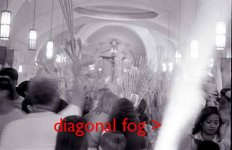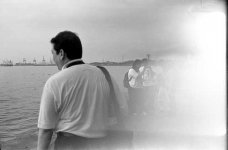payasam said:
ZorkiKat, ever wonder why those Leica bodies which are a single casting should need the diagonal strip of felt? I haven't so far been able to figure it out.
payasam said:
The IIIc of 1940 was the first Leica which was a single casting. Earlier models were built up of several components. One reason was to make manufacture less expensive, another was to increase strength to cope with the heavier lenses which had either come in or were planned.
payasam:
Which part of the Leica are you
really referring to? The
body shell or the shutter crate? I think you are confusing the parts or issues involved. First you referred to "single cast bodies", but when I commented about "
single cast body shells", you then refer to what appears to be a different "single casting" thingie without really making clear as to what it is.
BTW, you can't make a camera out of a "single casting". All of them need to be "built up of several components" in an assembly which takes up many steps😛
I've been
referring to the IIIc body shell at the start and why
the way it attaches to the shutter crate would require some light proofing somewhere in the assembly:
zorkikat said:
"...The original is just a strip of felt stuck on the body shell and runs from the notch where the slow knob sits, down to the bottom of the crate..."
The IIIc was the first production Leica to use a single cast (but not a single piece since the bottom part comes apart from the rest)
shutter crate. The crate is
cast with the top plate. This is what the
"single cast" description refers to. This made the crate more robust to have the potential of bearing heavier loads. In this case, the shutter crate bears the weight of the lenses, not the body shell. The lens mount is attached to a plate which in turn is attached to the shutter crate.
The older shutter crates found in earlier Leica were made of at least three parts. The 'walls' were rivetted to each other. The whole crate separates from the upper plate, and shutter assembly can be more difficult. In this version, the body shell mostly bears the weight of the mounted lens.
Whether the crate is "single cast" or made from several stamped components is not the issue why flocking is needed.
On the other hand, if you're talking about
body shells, the earlier II and III bodies were also in single pieces. My 1933 and 1936 III bodies have once been totally stripped of their vulcanite covering. They looked to be of single piece construction. No seams or any indication of having been "built of of several components". Perhaps there's a seam there above and below the lens mount to join the formed metal ends together, but finishing is so fine that this has become virtually invisible. One gets to look at the bare metal with a bit of attention for detail whilst priming and cleaning them prior to installation of the new leatherette trim.
You only need to compare both styles and see why one type really has to use gaskets.
payasam said:
I may find out why there is need for a strip of flocking: but in my time and by such means as I choose. Your monopoly over knowledge is not in danger.
Good luck. In the meantime, until you determine the reason why the flocking is there in IIIc Leicas, please try not to mock those who've already found out and in the process of finding out more.




